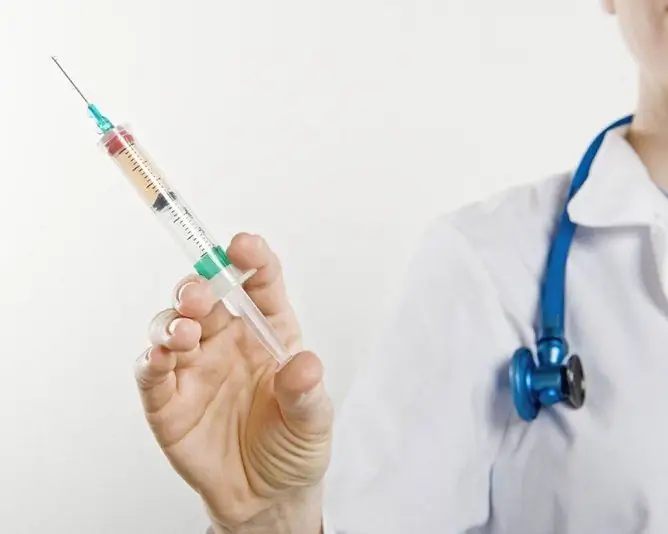- Author Rachel Wainwright [email protected].
- Public 2023-12-15 07:39.
- Last modified 2025-11-02 20:14.
Timexon
Timekson: instructions for use and reviews
- 1. Release form and composition
- 2. Pharmacological properties
- 3. Indications for use
- 4. Contraindications
- 5. Method of application and dosage
- 6. Side effects
- 7. Overdose
- 8. Special instructions
- 9. Application during pregnancy and lactation
- 10. Use in childhood
- 11. In case of impaired renal function
- 12. For violations of liver function
- 13. Use in the elderly
- 14. Drug interactions
- 15. Analogs
- 16. Terms and conditions of storage
- 17. Terms of dispensing from pharmacies
- 18. Reviews
- 19. Price in pharmacies
Latin name: Timexon
ATX code: L03AX13
Active ingredient: Glatiramer acetate
Manufacturer: CJSC Biocad (Russia)
Description and photo update: 2019-10-07
Prices in pharmacies: from 7280 rubles.
Buy

Timekson is an immunomodulatory agent.
Release form and composition
Dosage form - solution for subcutaneous administration: from colorless to light yellow, slightly opalescent (1 ml each in three-component sterile syringes made of neutral colorless glass, 1 syringe in a blister strip, in a cardboard box 28 packs complete with 28 alcohol wipes, as well as instructions for the use of Timekson).
Composition of 1 ml solution:
- active substance: glatiramer acetate - 20 or 40 mg;
- auxiliary components: water for injection, mannitol.
Pharmacological properties
Pharmacodynamics
Glatiramer acetate - the active substance of Timexon - is an acetic acid mixture of synthetic polypeptides formed by four natural amino acids: L-lysine, L-tyrosine, L-alanine and L-glutamic acid. In terms of chemical structure, it has elements of similarity to the basic protein of myelin.
Glatiramer acetate alters the course of the pathological process in a demyelinating disease of the central nervous system (CNS), such as multiple sclerosis, which is an autoimmune disease and changes the ratio of T-suppressors in the body.
Timexon has an immunomodulatory effect, mediated through the systemic spread of activated T-suppressors. The basis of its specific mechanism of action is the ability to competitively replace antigens (basic protein) of myelin, myelin oligodendrocytic glycoprotein and proteolipid protein from the antigen-presenting cells located on the sites of their binding to the molecules of the main histocompatibility complex of class 2. Due to competitive displacement, two reactions occur: antigen-specific inhibition effector T-lymphocytes (Th1-type) and stimulation of antigen-specific suppressor T-lymphocytes (Th2-type). Activated T-suppressor lymphocytes first enter the systemic circulation, then enter the central nervous system and enter the site of inflammation, where they are reactivated by myelin antigens. As a result, anti-inflammatory cytokines are formed (including IL-4, IL-6, IL-10), which suppress the local inflammatory T-cell response and reduce local inflammation. This promotes the accumulation of specific anti-inflammatory Th2-type cells and induces inhibition of the pro-inflammatory Th1-cell system.
Glatiramer acetate also stimulates the synthesis of the neurotrophic factor Th-2 by cells. It has a neuroprotective effect (protects the brain structures from damage).
The fundamental difference between Timekson and non-specific immunomodulators (including beta-interferons) is that it does not have a generalized effect on the main links of the body's normal immune responses.
Formed antibodies to glatiramer acetate do not have a neutralizing effect, which reduces the therapeutic efficacy of the drug.
Pharmacokinetics
Glatiramer acetate has a special chemical structure in the form of a mixture of polypeptides formed by natural amino acids. In addition, it is used in a low therapeutic dosage. In this regard, the data on its pharmacokinetics are indicative.
Based on these and experimental results, it is assumed that after subcutaneous (sc) administration of glatiramer, acetate is rapidly hydrolyzed at the injection site. Hydrolysis products and a small amount of unchanged glatiramer acetate can enter the lymphatic system and partially enter the vascular bed. The concentrations of the drug and its metabolites determined in the blood do not correlate with the therapeutic effect.
Indications for use
- the only episode of demyelination, which is based on an acute inflammatory process, requiring the administration of intravenous glucocorticosteroids (to slow down the development of clinically significant multiple sclerosis);
- relapsing-relapsing multiple sclerosis (to slow the development of disabling complications and reduce the frequency of exacerbations).
Contraindications
Absolute:
- age up to 18 years;
- period of pregnancy;
- hypersensitivity to any component of the drug.
Relative (it is required to use Timexon with caution):
- impaired renal function;
- cardiovascular diseases;
- predisposition to the development of allergic reactions.
Timekson, instructions for use: method and dosage
Timexon is administered subcutaneously at a dose of 20 mg once a day, preferably at the same time of day. Treatment is long, the decision to cancel the drug is taken by the attending physician.
Each pre-filled syringe is designed for a single use.
Rules for using the drug:
- Take one blister strip out of the refrigerator and keep at room temperature for about 20 minutes.
- Wash hands thoroughly with soap and water.
- Inspect the drug for damage to the syringe, discoloration of the solution, or the presence of suspended particles.
- Select the area for injection, the recommended ones are: the back of the shoulder, the front of the thigh (except for the knee and groin), the abdomen (except for the umbilical region and the white line), buttocks. Do not inject into painful spots, reddened or discolored areas, areas with nodules and lumps. To reduce discomfort and pain with the injection, you should alternate injection sites and / or points within the same area daily. It is recommended to draw up and always have with you a scheme for changing injection sites. In some areas (such as the arms and buttocks), it is difficult to inject yourself on your own, so you may need help from another person.
- Treat the injection site with an alcohol wipe.
- Remove the syringe from the individual packaging. Take it in a comfortable hand and remove the protective cap from the needle.
- With the other hand, gently fold the skin with your thumb and forefinger.
- Position the syringe perpendicular to the injection site and insert the needle into the skin at a 90 ° angle.
- Smoothly pressing the plunger, inject all the drug contained in the syringe.
- Keeping the same angle of inclination, remove the syringe with the needle by moving it vertically upwards.
- If necessary, attach a dry, sterile cotton swab to the injection site and seal with a plaster. Do not massage or rub the area of Timexon injection.
- Dispose of the used syringe in the designated area.
If the injection of Timexon is missed, the drug should be administered as soon as possible. Double dose is not allowed. The next syringe can be used 24 hours after the previous one.
Side effects
Timexon is a safe drug that is well tolerated.
In some cases, the following side effects are possible:
- infectious lesions: rhinitis, otitis media, pyelonephritis, gastroenteritis, bronchitis, furunculosis, inflammation of the subcutaneous fat, herpes zoster, vaginal candidiasis, exacerbation of diseases caused by Herpes simplex;
- from the endocrine system: hyperthyroidism;
- on the part of the cardiovascular system: varicose veins, sinus bradycardia, increased blood pressure, palpitations, extrasystole, paroxysmal tachycardia, tachycardia;
- from the immune system: anaphylactoid reaction, hypersensitivity reactions, angioedema;
- from the respiratory system: shortness of breath, cough, seasonal rhinitis, laryngospasm, hyperventilation, apnea;
- from the central and peripheral nervous system: dyslexia, dysgraphia, myoclonus, anxiety, headache, hallucinations, nervousness, hostility, euphoria, depression, personality disorder, mania, migraine, taste perversion, cognitive impairment, fainting, psychosis, stupor, neuromuscular blockade, neuritis, convulsions, tremors, impaired motor functions, tunnel syndrome, pathological dreams, paralysis (including the peroneal nerve), suicidal behavior;
- on the part of the organ of hearing and balance: hearing impairment;
- on the part of the organ of vision: visual impairment, diplopia, corneal damage, impaired eye movement, nystagmus, eyelid ptosis, visual field defect, subconjunctival hemorrhage, dry sclera and cornea, optic nerve atrophy, mydriasis, cataract;
- from the side of metabolism: a decrease in the concentration of ferritin in the blood serum, hypernatremia, hyperlipidemia, anorexia or increased body weight, gout, alcohol intolerance;
- from the digestive system: odontogenic periostitis, caries, swelling of the tongue, enlarged salivary glands, belching, dyspepsia, constipation, dysphagia, vomiting, esophageal ulcer, nausea, colitis, colon polyposis, enterocolitis, rectal bleeding, anorectal disorders;
- from the liver and biliary tract: hepatomegaly, gallstone disease;
- on the part of the urinary system: urinary retention, pollakiuria, hematuria, urge to urinate, nephrolithiasis;
- on the part of the musculoskeletal system and connective tissue: side pain, bursitis, back pain, arthritis, pain in the cervical spine, osteoarthritis, arthralgia, muscle atrophy;
- from the blood and lymphatic system: changes in the structure of lymphocytes, leukopenia, leukocytosis, splenomegaly, lymphadenopathy, thrombocytopenia;
- on the part of the genitals and mammary glands: pelvic organ prolapse, vulvovaginal disorders, menstrual irregularities, amenorrhea, deviation of laboratory parameters in smears from the cervical canal, enlargement of the mammary glands, erectile dysfunction;
- from the skin and subcutaneous tissues: contact dermatitis, skin nodules, erythema nodosum, hyperhidrosis, pruritus, ecchymosis, urticaria, skin rash;
- local reactions: redness, pain, hematoma, lipoatrophy, abscess, edema, skin necrosis;
- others: chills, fatigue, asthenia, fever, peripheral edema, nosebleeds, a feeling of a hangover.
In addition, Timexon is capable of causing systemic reactions, such as difficulty swallowing, chest pain, shortness of breath, palpitations, hot flashes, anxiety, urticaria. These symptoms are limited and temporary, may occur sporadically, and may also occur several months after starting the drug. No special intervention is required.
Overdose
There have been no reports of overdose of glatiramer acetate.
If the recommended dose is significantly exceeded, it is required to carefully monitor the patient's condition, and if necessary, prescribe symptomatic therapy.
special instructions
Treatment with the drug should be carried out under the supervision of a physician experienced in the treatment of multiple sclerosis. At the initial stage, the supervision of a neurologist is required.
Timexon is an immunomodulatory drug that can change the protective functions of the body, therefore, periodically during treatment, the state of the patient's immune system should be checked.
Patients should be informed about possible side effects. Most of them are short-lived and go away on their own without any consequences. If serious reactions occur, you need to cancel Timexon and call an ambulance or consult your doctor.
Immediately after the injection, chest pain may occur. It usually lasts several minutes, has no connection with other disorders and goes away on its own without consequences. The mechanism for the development of this symptom is unknown.
With prolonged treatment (from several months), lipoatrophy may develop at the injection sites, in isolated cases - skin necrosis. To prevent these reactions, patients should strictly follow the recommendations for alternating injection sites and points within the same area.
Influence on the ability to drive vehicles and complex mechanisms
Given the safety profile of Timekson, there is no need to take special precautions when performing potentially hazardous activities, including driving vehicles.
Application during pregnancy and lactation
There is no information on the use of glatiramer acetate during pregnancy, the possible risks have not been established, therefore, the use of Timexon is contraindicated in pregnant women.
The penetration of the drug into breast milk is unknown. The appointment of Timexon during lactation is possible after assessing the expected benefits and potential risks.
Pediatric use
Due to the lack of data on the safety and efficacy of glatiramer acetate in pediatric patients, Timexon is not used to treat children and adolescents under 18 years of age.
With impaired renal function
Care must be taken when using Timexon in patients with renal impairment.
For violations of liver function
There are no data on changes in the pharmacokinetics of glatiramer acetate in functional liver disorders.
Use in the elderly
There are no data on changes in the pharmacokinetics of Timexon in elderly patients.
Drug interactions
The interaction of glatiramer acetate with other medications has not been studied enough.
Cases of negative drug interactions are unknown. Timexon can be used concomitantly with drugs used to treat multiple sclerosis, including corticosteroids (in combination therapy up to 28 days).
Analogs
Timekson analogs are Axoglatiran FS, Glatirat, Copaxon 40, Copaxon-Teva.
Terms and conditions of storage
Store at a temperature of 2 to 8 ° C out of reach of children.
Shelf life is 2 years.
Terms of dispensing from pharmacies
Dispensed by prescription.
Reviews about Timekson
Timexon is a domestic analogue of the well-known Israeli drug Copaxone, therefore, in specialized forums, patients mainly compare these two drugs. According to reviews, Timekson is no less effective, its side effects are not particularly different. However, it is noted that after the injection of Timekson, more pronounced local reactions occur, especially pain at the injection site.
The price of Timexon in pharmacies
The price for Timexon for a cardboard box containing 28 syringes in blister strip packaging averages 8,000 rubles.
Timekson: prices in online pharmacies
|
Drug name Price Pharmacy |
|
Timexon 20 mg / ml solution for subcutaneous administration 1 ml 28 pcs. RUB 7280 Buy |

Maria Kulkes Medical journalist About the author
Education: First Moscow State Medical University named after I. M. Sechenov, specialty "General Medicine".
Information about the drug is generalized, provided for informational purposes only and does not replace the official instructions. Self-medication is hazardous to health!






